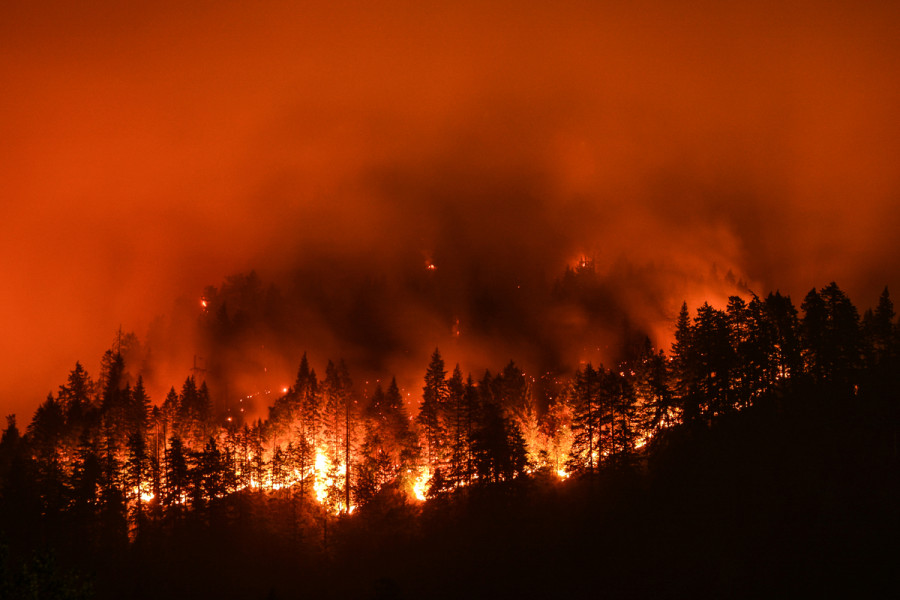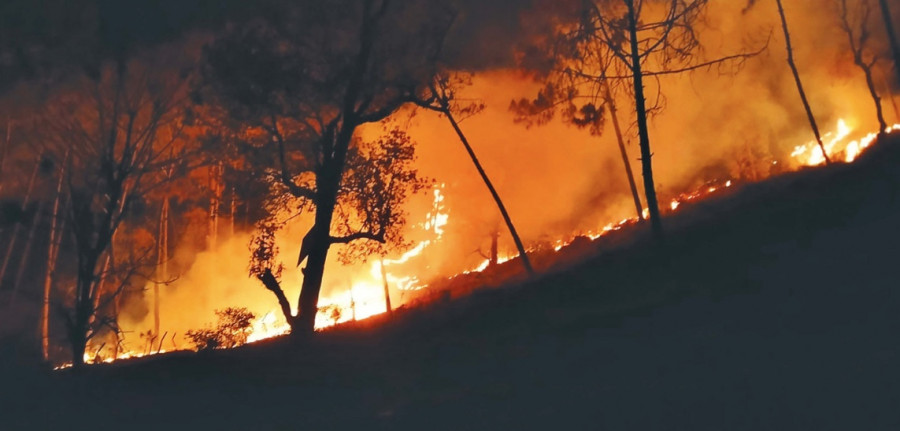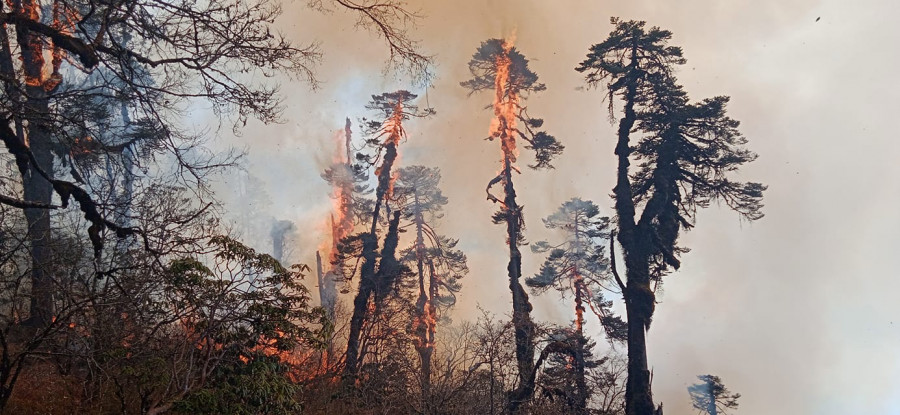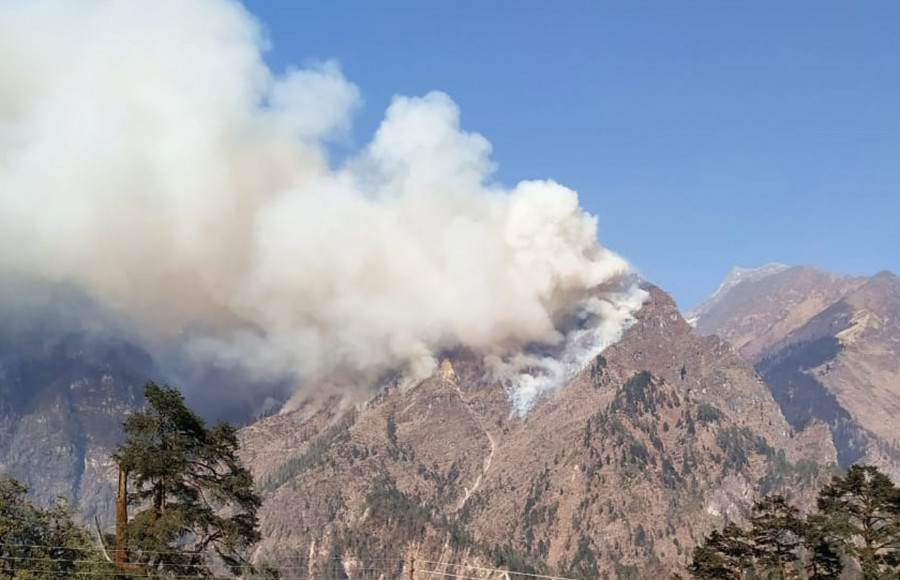Nepal’s forest fires under control, but peak wildfire season has just begun
Since last November, Nepal has recorded over 2,700 wildfire incidents in 73 of its 77 districts. High levels of air pollution forced authorities to shut all educational institutions. Recent rains have extinguished a large number of fires, but the threat of more wildfire remains.


Since last November, Nepal has recorded over 2,700 wildfire incidents in 73 of its total 77 districts. (Filed pic). Source: Shutterstock
Like every other morning, Sujita Dhakal woke up and peeped outside the window of her house in Kathmandu. All she could see was dark grey haze. Rubbing her itchy eyes, she peered out again.
“All I saw was a thick blanket of haze. It was smoggy. My eyes were burning, and it seemed like some big disaster had struck us,” Dhakal, who works as an assistant programme officer with RECOFTC (The Center for People and Forests) Nepal, told Gaon Connection.
Till a couple of days ago, Nepal was in midst of a major forest fire crisis. About 73 of the country’s 77 districts were affected by wildfire. Predictably, the air quality had turned poisonous and residents like Dhakal had a burning sensation in their eyes and breathing difficulties too. Poor visibility meant flight movement was affected too.
On March 30, the Nepal government shut down all educational institutions for four days. Mercifully, it rained two days ago and that helped put out a large number of wildfires. Some continue to rage. Educational institutions reopen from April 4.

Pic: The Kathmandu Post
However, the threat of widespread forest fires is far from over. “Till a week ago, we had five hundred-plus plus forest fires across the country, which have come down to fifty-nine on the first of April. But, the threat is still not over, as the peak season for wildfires in Nepal is April and May,” Chandan Kumar Mandal, environment and migration reporter for The Kathmandu Post, told Gaon Connection. He has been extensively reporting on the ongoing forest fires in Nepal.
“Can you believe that while the forests burnt and citizens suffered, schools were shut down and flights affected, the government still did not declare it a national emergency?” said Dhakal.
Also Read: Odisha forest fires: Similipal Tiger Reserve continues to burn; Kuldiha sanctuary in flames too
Meanwhile, the recent wildfires have made clear the link between the worrisome issue of burning the country’s rich natural resources and air pollution. “For once, the residents of Kathmandu started comparing their situation with the high levels of air pollution in Delhi-NCR or Beijing. The connection between wildfires and air pollution has become clear,” said Divya Gupta, senior research fellow with the School of Public Policy at ISB Hyderabad. She has worked extensively on natural resource governance issues for almost 10 years.
“The recent forest fires in Nepal also remind one of the massive wildfires in Australia, or the ones in the Pacific Northwest in the US. The reasons for these fires are many, and climate change [rising temperature and heatwaves] acts as a trigger,” she told Gaon Connection.

Nepal’s forests and wildfires
Nepal’s total forest area is 6.4 million hectares (including shrubland), which represents about 44.7 per cent of the country’s total physical area. Over the past three decades, the government has gradually transferred forests to Community Based Forest Management (CBFM) groups, who now manage about two million hectares or about 34 per cent of Nepal’s forest cover.
The forest fire season starts from November and goes on till the arrival of the southwest monsoon, which arrives in the Himalayan country around June 10. These CBFM groups are responsible for managing forest fires too.
Also Read: Uttarakhand villagers launch another Chipko Andolan to protect their sacred grove
“Forest fires are common in Nepal. Some of them are due to natural factors and some human-induced, as local people burn shrubs to clear land for farming or for regeneration of fodder for their cattle,” Ramesh Bhushal, a resident of Kathmandu, and the South Asia coordinator of Internews’ Earth Journalism Network, told Gaon Connection.
“But what has happened this year is unprecedented. We have had a record two thousand seven hundred forest fires since November last year. This is pretty high compared to previous years,” said Bhushal.

Different reasons are being attributed to the high incidence of forest fires this year. Firstly, Nepal has had below normal winter rainfall and the weather forecast shows below normal rainfall in the ongoing pre-monsoon season too. This has increased dryness in the forests, said Dhakal.
Secondly, due to the COVID-19 pandemic and the lockdown, last year, local villagers could not go to the forests to collect firewood, twigs and dry grass. Also, cattle were not taken to the forests for grazing. “This increased the dry cover in the forests, providing fertile ground for wildfires. People also set forests on fire for cultivation or poaching,” said Mandal.
According to Dhakal, although community groups have been given the responsibility of managing forests, they lack human resources, and require training and equipment to respond to forest fires.
“Because of the geography of Nepal, the country constantly faces repeated disasters, be it wildfires, earthquakes, droughts or flash floods. The scale of disasters is massive and there is prolonged impact. The country lacks resources to tackle these successive disasters,” said Gupta.
Nepal’s Forest Fire Management Strategy
The Government of Nepal prepared its Forest Fire Management Strategy 2010 a decade ago. The strategy has four pillars for forest fire management — Policy, legal and institutional development and improvement; Education, awareness raising, capacity building and technology development; Participatory (involving local community) fire management and research; and Coordination and collaboration, international cooperation, networking, and infrastructure development.
The goal of the strategy is ‘to mitigate loss of life, property, biodiversity and ecosystem by properly managing forest fires to increase productivity of forests’. Among many things, it talks about multi-stakeholder involvement, community-based emphasis, capacity building, raising awareness, communication and coordination.
“But, all this is only on paper. Even after a decade of the release of this strategy, there is no action plan for the strategy… Our forests have been on fire and we still do not know how much total forest cover we have lost due to wildfires since November last year,” said Dhakal.
All eyes in the Himalayan nation are now towards the sky, awaiting the southwest monsoon. They expect it to provide the much needed respite to the country’s burning forests.

